Getting to know Montana’s deer is stepping into the world of the smallest and most common deer. Mule deer and white-tailed deer roam the state, with mule deer more prevalent and white-tailed deer often found in specific regions. This makes it essential to spot their differences, especially when hunting.
This guide will help you identify these deer, understand their unique traits, and explore their habitats in Montana. We will explore the distinct features of mule deer and white-tailed deer. Each characteristic sets them apart, from their coat colors to their movement.
- Related article: Wildlife Discovery in Montana
What makes spotting a mule deer exciting? How do you prepare to observe the more elusive white-tailed deer? Discovering the world of Montana’s deer can open your eyes to nature’s beauty. Join us as we dive into the details of these fascinating creatures and their role in Montana’s ecosystem.
7 Key Takeaways on Montana’s Deer Diversity and Hunting
- Deer in Montana consists primarily of mule deer and white-tailed deer, with distinct characteristics making them easily recognizable.
- Known for their large ears and adaptability, Montana’s mule deer face challenges like harsh winter conditions and habitat loss.
- There are two primary categories of mule deer: the black-tailed and mule deer.
- With their unique scent glands and social behaviors, white-tailed deer are found throughout most of North America east of the Rocky Mountains.
- There are 26 subspecies of white-tailed deer and 17 of them are found in North America.
- Both deer species exhibit diverse subsistence patterns and reproductive characteristics based on their habitats.
- Deer hunting in Montana offers rich opportunities but is impacted by population fluctuations and requires a good understanding of deer behavior and distribution.
Comparing Montana Deer Types
Let’s dive into the world of Montana’s deer. Why are they so important to know? As the smallest and most abundant members of the deer/elk/moose family, deer play a big role in the state’s natural balance. Here, we focus on two key players: the mule deer and the white-tailed deer.
Identifying these deer correctly is crucial, especially when hunting. The first step is to know your bucks (male deer) from your does (female deer). Both mule and white-tailed deer offer unique challenges and experiences.
Here’s how to tell apart mule deer and white-tailed deer:
| Characteristic | Mule Deer | White-Tailed Deer |
|---|---|---|
| Coat Color | Mule deer coats are gray in winter and brownish in summer. | White-tailed deer coats are grayish-brown in winter and reddish-brown in summer. |
| Tail | Mule deer tail is rope-like white with a black tip. | The white-tailed deer tail is brown with white fringe, and the erect tail is all white. |
| Ears | Mule deer ears are large in proportion to the head. | White-tailed deer ears are smaller in proportion to the head. |
| Antlers | Mule deer’s antler shapes are forked. The average buck has 4 tines (or 5 with brow tines). | White-tailed deer antlers have main beams with 3 to 5 tines. |
| Brow Tines | Mule deer brow tines are shorter or absent. | White-tailed deer brow tines are long. |
| Movement | Mule deer movements are more gregarious, migratory, and mostly elevational movements. | White-tailed deer occupy small home ranges and do not migrate far. |
Despite some overlapping habitats and the rare event of hybridization or interbreeding, telling mule and white-tailed deer apart is usually straightforward. Their behaviors, biology, and appearances have key differences. For example, their antler configurations and rump colors are distinctive.
While white-tailed deer have a broad North American range, mule deer are more specific to the western areas of the Rocky Mountains. In Montana, both types are present in the Greater Yellowstone Ecosystem. Mule deer are more common across the park’s various habitats, while white-tailed deer stick close to water sources in the northern range.
Look for these differences when you’re out and about in Montana. Understanding the deer roaming the state’s vast landscapes adds a rich layer to your outdoor adventures.
About Montana Mule Deer
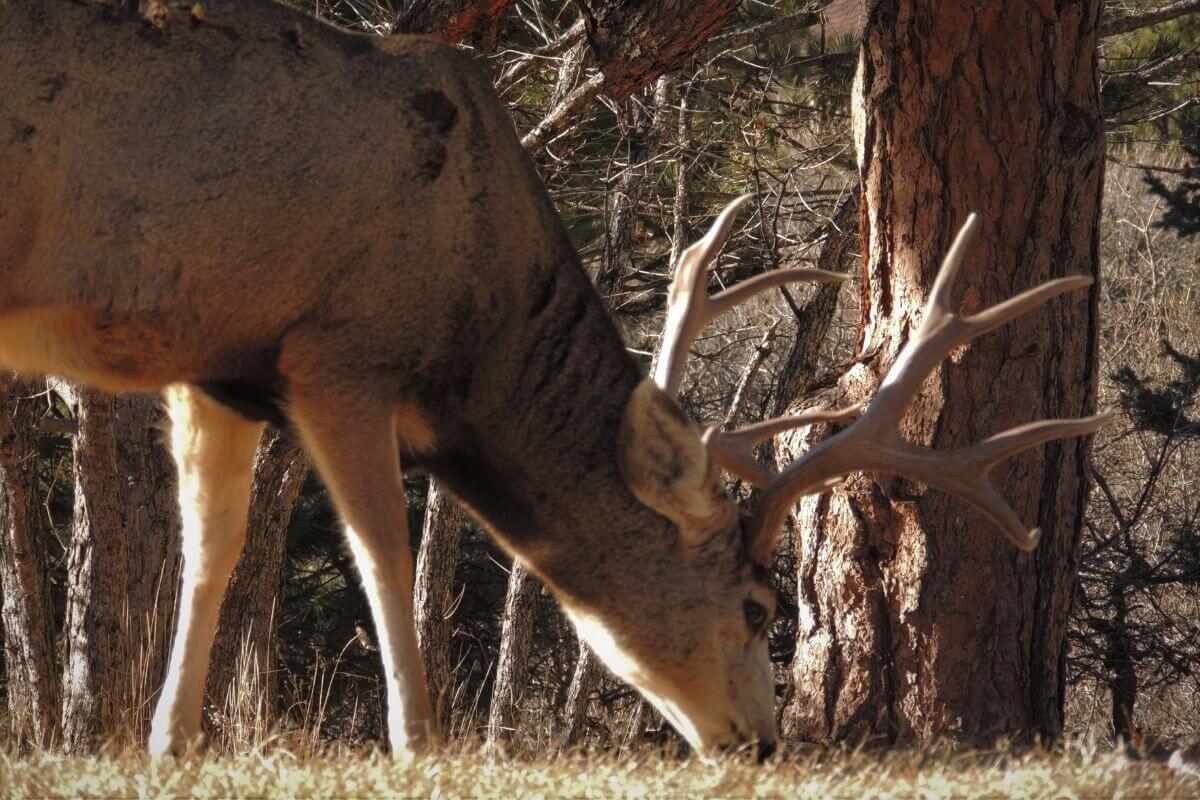
When you’re out in Montana and you see a deer with big ears, chances are you’re looking at a mule deer. These deer are known for their impressive jumping abilities and adapting to the state’s varying landscapes. Montana’s mule deer are essential to the state’s wildlife diversity.
Montana Mule Deer Description
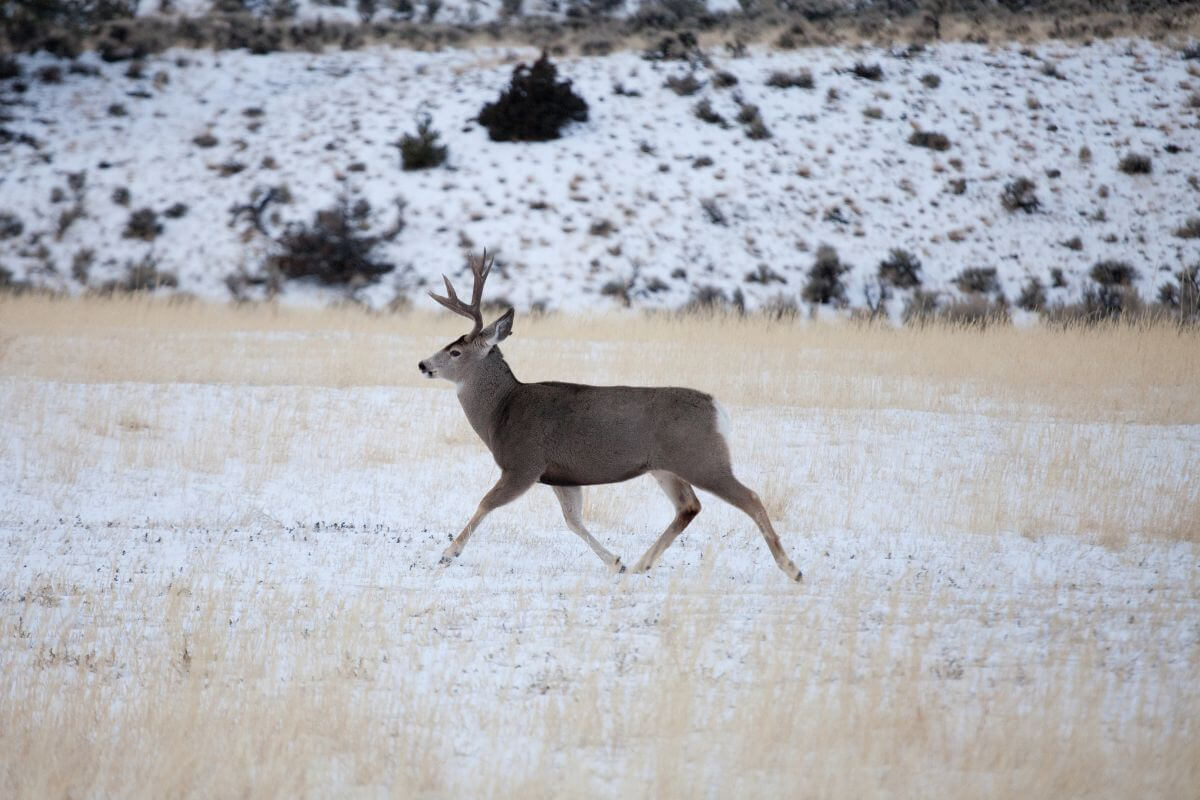
Mule deer (Odocoileus hemionus) are known as ‘The Deer of the West’ for a good reason. They’re not just deer but icons of the western part of North America. When you see a deer with super-sized ears that remind you of a mule, you’re looking at a mule deer.
Mule deer’s ears are special. They help mule deer hear better in the wild, making them stand out among other deer. Because of these unmistakable ears, the name hemionus in their title means ‘half-mule’.
Let’s break down what makes Montana mule deer unique beyond their ears:
- Coat – The mule deer has a dark forehead and brisket. Their chin, throat, and rump patch are white.
- Scent Gland – Mule deers have a slit-like scent gland outside their hind foot that can grow to 7 inches long.
- Weight – Mature mule bucks can weigh 250 to 275 lbs if they have good land to roam, while does weigh 160 to 180 lbs.
- Behavior – Mule deer often eat early in the morning and late in the evening. When they run, they keep their tails down and leap with all four feet.
- Migration – Mule deer migration involves extensive travel through mountain and foothill regions.
- Habitat – Mule deer habitat varies between areas and seasons, ranging from grasslands with some bushes to forest areas with dense trees.
- Food Habits – Mule deer diets vary annually, including bitterbush, mountain mahogany, fruits such as chokecherry and serviceberry, grasses, and other plants.
- Ecology – Sometimes there are a lot of mule deer, sometimes not so many. And when there are a lot, farmers might not be so happy because they eat their crops.
- Reproductive Characteristics – Mule deer can become parents for the first time when they’re about a year old. During the breeding season, dominant bucks mate with more than one doe.
Now, life isn’t always easy for mule deer. They have to deal with severe winters and deep snow, which makes finding food tough and decreases their numbers. Plus, things like losing their homes to construction and hunting make life even harder for them.
Mule deer face several challenges today, including severe weather that makes food scarce and diseases from other animals. Despite these issues, they remain significant to people in the West, where hunting and wildlife watching are popular activities.
These deer spread across western North America in open areas with bushes, including Yellowstone in the summer months. They are a key part of the local economy and culture.
Mule deer are tough and adaptable but need our help to survive. Protecting mule deer, their homes, and food sources and managing hunting numbers help preserve an essential part of the West’s heritage.
Mule Deer Subspecies
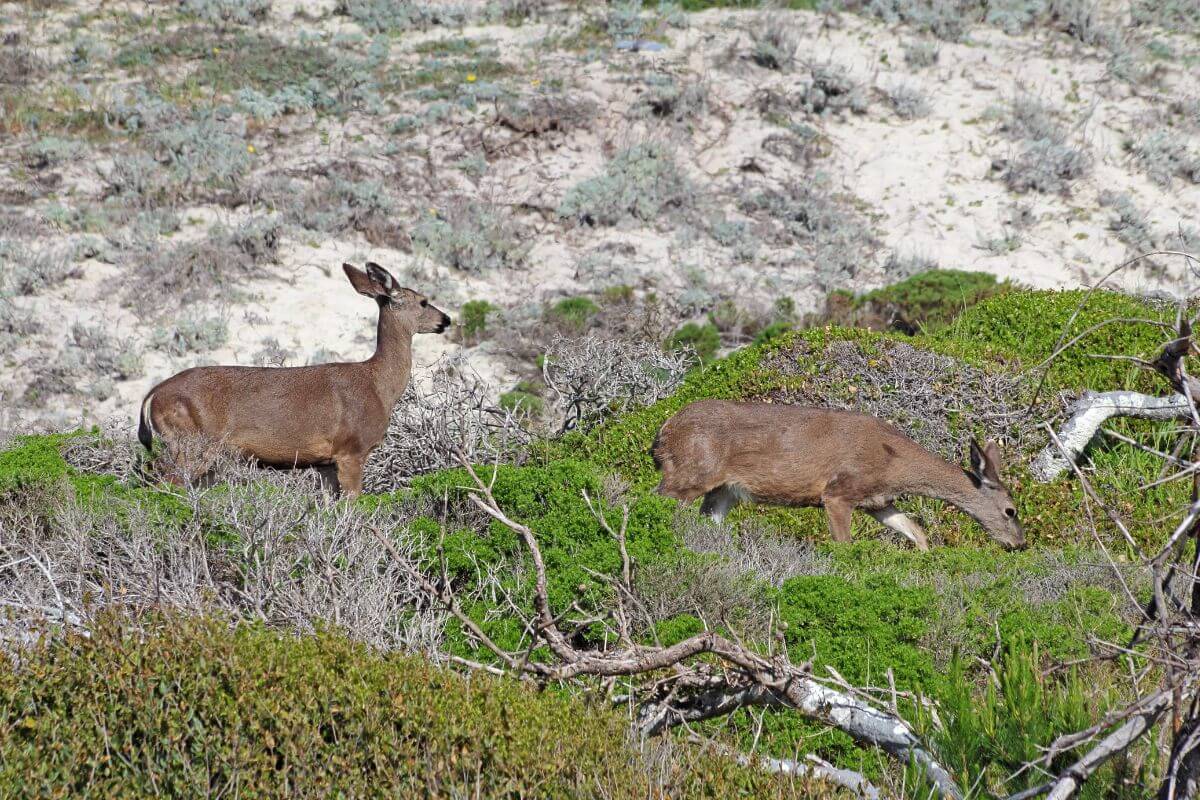
Mule deer are fascinating creatures that show great diversity along their territories. Their range covers various landscapes, leading to differences in appearance and behavior. These also include body size, antler shape, and even genetic makeup.
They are generally divided into the mule deer and the black-tailed deer. People used to think they were distinct enough to be a separate species, but nature had other plans. Nowadays, most experts see them as cousins, and evidence shows that they interbreed and occasionally blend their genetics as a result.
Let’s take a closer look at the mule deer group. Within this species, there are several “subspecies,” which are groups with unique traits. Here’s a basic overview of the primary mule deer group:
- California Mule Deer (Odocoileus hemionus californicus) – As the name suggests, the California mule deer inhabits the state of California.
- Cedros Island Mule Deer (Odocoileus hemionus cerrosensis) – The Cedros/Cerros Island mule deer is named after Cedros Island, the only place the subspecies is found.
- Bura Mule Deer (Odocoileus hemionus eremicus) – Sometimes called desert or burro mule deer, the Bura mule deer is found in the Lower Colorado River Valley, northwestern Mexico, southeastern California, and Arizona.
- Southern Mule Deer (Odocoileus hemionus fuliginatus) – Southern mule deer enjoy the sunny days in the south of California and Baja California.
- Rocky Mountain Mule Deer (Odocoileus hemionus hemionus) – Rocky Mountain mule deer roam around western and central North America.
- Inyo Mule Deer (Odocoileus hemionus inyoensis) – Named after Inyo County in California, Inyo mule deer hike through the Sierra Nevada mountain range.
- Peninsula Mule Deer (Odocoileus hemionus peninsulae) – Peninsula or Peninsular mule deer enjoy the landscapes of Baja California Sur.
- Tiburon Island Mule Deer (Odocoileus hemionus Sheldon) – The Tiburon Island mule deer lives a secluded life on Tiburón Island.
The blacktail subspecies include:
- Columbian Black-Tailed Deer (Odocoileus hemionus columbianus) – The Columbian blacktails are Pacific Northwest and Northern California residents.
- Sitka Black-Tailed Deer (Odocoileus hemionus sitkensis) – Named after Sitka, Alaska, Sitka black-tailed deer are found on the coast of western British Columbia.
These distinctions aren’t just for show. They help us understand how amazing and adaptable these creatures are. Their differences in size, color, and location are all part of what makes them so special.
About Montana White-Tailed Deer

Montana’s landscape is home to a rich variety of deer, including the graceful white-tailed deer. These deer are more than just a sight, they are a key part of the state’s natural beauty and ecosystem. Let’s explore what makes Montana’s white-tailed deer unique and their role in the state’s wild outdoors.
Montana White-Tailed Deer Description
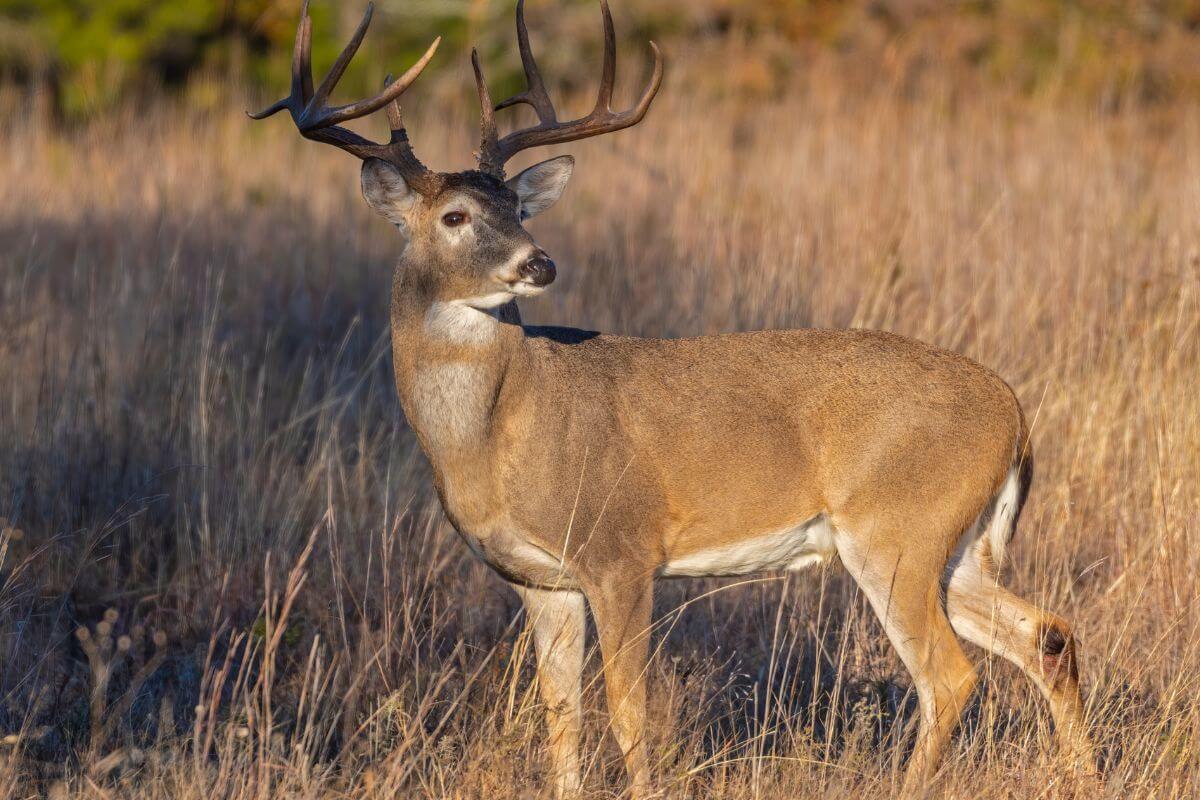
Montana’s white-tailed deer (Odocoileus virginianus) stands out with its unique features. It sports a small, teardrop-shaped scent gland outside its lower hind foot. This intriguing gland plays a role in communication and is a distinctive part of its biology.
Here are some key insights into Montana’s white-tailed deer:
- Weight – Mature whitetail bucks reach 250 to 275 lbs when food is plenty, showing how their environment influences their size. On the other hand, does weigh in at 160 to 180 lbs.
- Behavior – White-tailed deer are mostly active at night and prefer to keep to themselves, although they come together in small groups where they like to eat. They raise and wave their tails when scared or running, revealing the white underside.
- Habitat – White-tailed deer make their homes in various places, from the lush vegetation along rivers and creeks to the dense plants higher up and sometimes even on open hillsides. It’s all about having enough food resources and a safe living place for them.
- Food Habits – White-tailed deer eat leaves, twigs, and fruits from chokecherry, serviceberry, snowberry, and dogwood, which helps them survive and thrive.
- Reproductive Cycle – The breeding season for white-tailed deer starts in mid-to-late November. In the spring, they usually have one or two babies called fawns. Unlike certain deer, white-tailed bucks don’t engage in large group fights over does during this period. However, you can spot a buck seeking a mate by observing its neck, which becomes more prominent.
- Migration – While some animals travel long distances each year, white-tailed deer in Montana move between their summer and winter ranges in the western part of the state as long as they have what they need in both places.
White-tailed bucks are known to be more aggressive than mule deer bucks. They often fight, especially if they’re the leaders of their area. This combat allows the strongest bucks to show who’s in charge.
Unlike mule deer, white-tailed deer tend to remain in the same area throughout the year if there are sufficient food and shelter resources. Their higher reproductive rate enables them to thrive and expand their population when conditions are favorable.
These deer are a fascinating part of Montana’s wildlife. They show how they adapt and live based on the availability of food resources and safe areas.
White-Tailed Deer Subspecies

It’s fascinating to dive into the world of white-tailed deer and discover the incredible diversity among their subspecies. Across Central and North America, as well as South America, these deer have developed unique characteristics in response to their environments.
Let’s dive into the diverse range of white-tailed deer subspecies found primarily in North and Central America, including but not limited to:
- Acapulco White-Tailed Deer (Odocoileus virginianus acapulcensis) – The Acapulco White-tailed Deer is found in southern coastal Mexico.
- Avery Island White-Tailed Deer (Odocoileus virginianus mcilhennyi) – The Avery Island white-tailed deer is found on Avery Island in Louisiana.
- Blackbeard Island White-Tailed Deer (Odocoileus virginianus nigribarbis) – The Blackbeard Island white-tailed deer is a rare subspecies of the white-tailed deer found on Blackbeard Island, Georgia.
- Bulls Island White-Tailed Deer (Odocoileus virginianus taurinsulae) – The Bulls Island white-tailed deer inhabits Bulls Island, South Carolina.
- Carmen Mountains White-Tailed Deer (Odocoileus virginianus carminis)- The Carmen Mountains white-tailed deer inhabits the Texas-Mexico border and is known for being smaller with shorter tines.
In South America, the white-tailed deer subspecies include:
- Andean White-Tailed Deer (Odocoileus virginianus peruvianus) – The Andean white-tailed deer is found in southern Peru and possibly Bolivia, with its distribution extending southward.
- Curaçao White-Tailed Deer (Odocoileus virginianus curassavicus) – The Curaçao white-tailed deer inhabits Curaçao.
- Ecuador White-Tailed Deer (Odocoileus virginianus ustus) – The Ecuador white-tailed deer inhabits Ecuador, possibly southern Colombia and northern Peru.
- Llanos White-Tailed Deer (Odocoileus virginianus cariacou) – The Llanos white-tailed deer is found in French Guiana and northern Brazil.
- Margarita Island White-Tailed Deer (Odocoileus virginianus margaritae) – The Margarita Island white-tailed deer is found on Margarita Island in the Caribbean Sea.
The sheer number of white-tailed deer subspecies and their specific habitats showcase the species’ adaptability and diversity. Whether in North and Central America or South America, each subspecies has developed unique traits to thrive in its environment.
Overview of Montana Deer Hunting
| Deer Species | Population (2023) | Hunting Areas |
|---|---|---|
| Mule Deer | 255,989 | East and Central Montana |
| Whitetail Deer | 193,475 | River areas and big farmlands in Eastern Montana |
Montana is a top spot for deer hunting, and it’s no secret why. The state looks out for its hunters, especially regarding deer. Here’s the lowdown on what makes hunting deer in Montana so special:
- Mule Deer Hunting – Despite declining mule deer populations, Montana remains a promising spot to hunt bucks. In 2023, the state’s mule deer count stood at approximately 255,989, the lowest in recent years. Regions like Region 7 are particularly affected by this decline. Hunters in the eastern and central parts of the state are finding that they need to exert more effort to locate their prey.
- Whitetail Deer Hunting – Montana is home to about 193,475 whitetail deer. For whitetail hunting, the river areas and big farmlands in the east are where you want to be. Unless you’re up in the mountains out west, you’ll need access to private land to hunt whitetails. The state might not have as many whitetails as before, but there are still some great bucks.
Montana’s deer population is shifting, making hunting more challenging. Despite this, hunters can still succeed with the right knowledge and access to the right areas. Whether you’re after a mule deer or a whitetail, knowing where to look and understanding the current population trends is key to securing your tag.
Montana Deer Types Final Thoughts
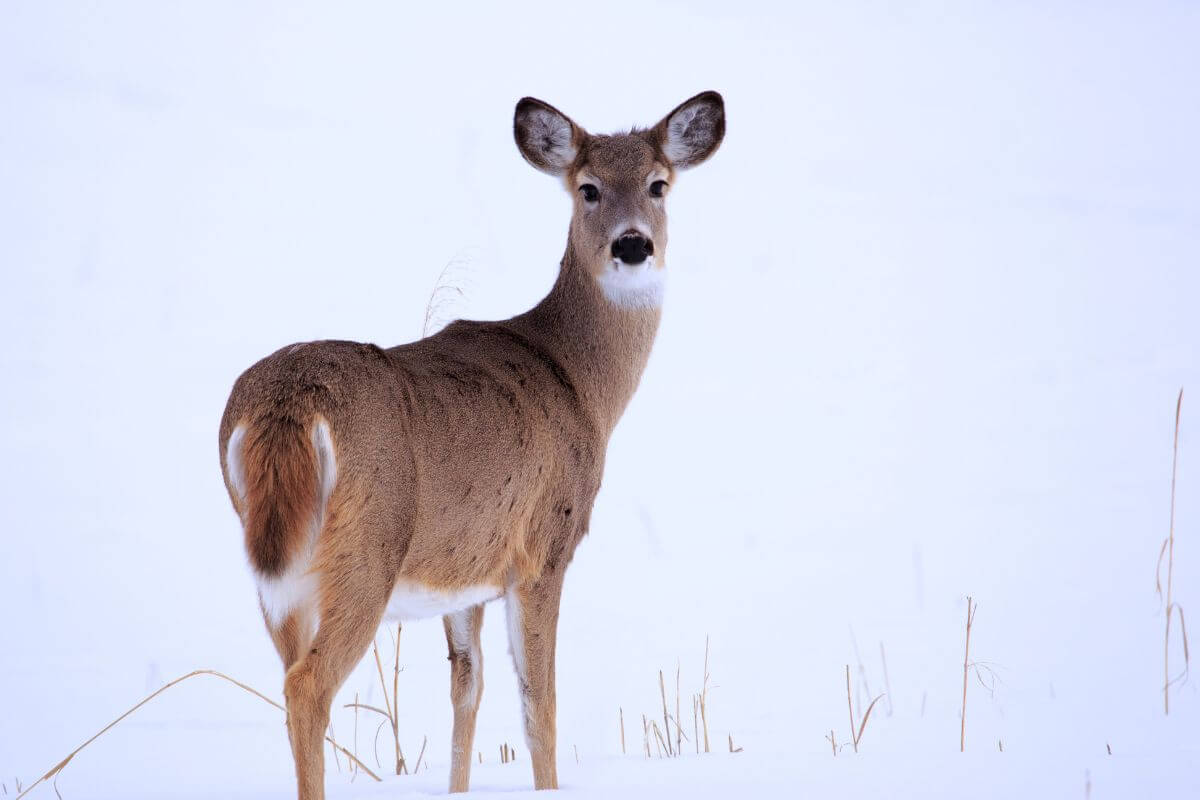
Montana’s mule and white-tailed deer are more than just animals, they are vital state’s identity. More importantly, they are crucial to maintaining Montana’s ecological balance.
Whether you plan on a deer hunting trip or wildlife observation, understanding where and how to locate these deer is vital. Learning about their obstacles, such as climate change impacts and habitat loss, is also important.
Each subspecies and their distinct characteristics improve our understanding of Montana’s diverse deer population. This awareness enhances our outdoor adventures and highlights the significance of conservation efforts.
Whether you’re a hunter or a nature lover, respecting and understanding Montana’s deer population is essential to preserving the state’s rich natural heritage.
Montana Deer Types FAQs
1. What Types of Deer Are in Montana?
The most widely distributed and abundant big game mammals in Montana are mule deer and white-tailed deer. Despite evolving to thrive in different environments, both species demonstrate remarkable adaptability.
These two deer species contribute significantly to Montana’s rich wildlife diversity and are popular targets for hunters in the state.
2. Does Montana Have Big Mule Deer?
Montana is known for having big mule deer. The state offers ample habitat and food sources for mule deer, which can contribute to the growth of large-bodied and trophy-sized individuals. Montana is a popular destination for hunters seeking trophy mule deer due to the quality of the deer population and the opportunity for successful hunts.
3. What Is a General Deer Combo in Montana?
In Montana, a General Deer Combo license is available to nonresidents, allowing them to apply for only one combination license per year. This license includes a General Deer license, which permits hunting deer and also authorizes fishing and hunting of upland game birds, excluding turkey.
4. Where Are Most Whitetail Deer in Montana?
Whitetail deer are found in all portions of Montana but tend to prefer certain habitats. They are commonly found in the vegetated areas of coulees along rivers and streams and in heavily forested areas of western Montana.
5. How Many Mule Deer Are in Montana?
The 2023 statewide estimate of mule deer in Montana was approximately 255,989 individuals. This estimate provides insight into the population size of mule deer within the state and helps inform wildlife management and conservation efforts.
Explore captivating articles diving into the richness of Montana:

